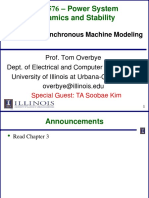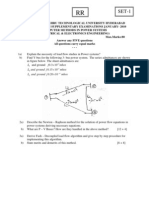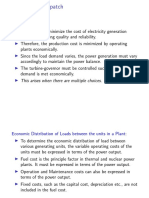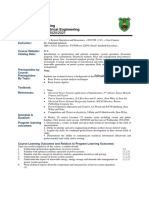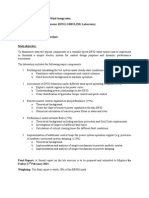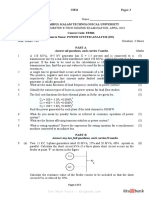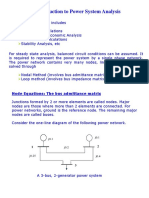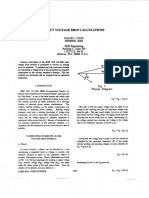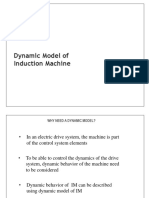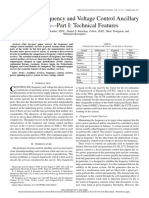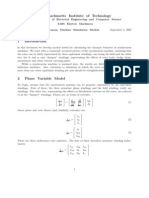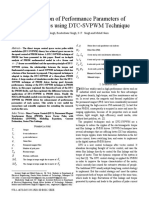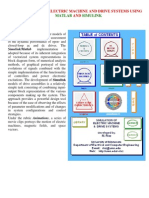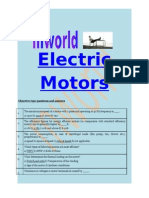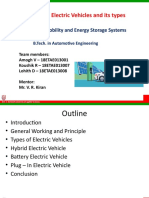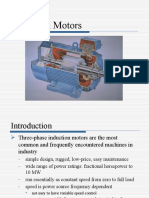CHAPITRE II
TRANSIENTS IN SYNCHRONOUS MACHINES
INTRODUCTION
In steady state, the magneto-motive force (mmf) of the rotor is stationary with respect to the
rotating armature mmf. Thus the fluxes linked by the rotor windings do not change with time
and no voltage in induced in these windings. The single phase equivalent circuit simplifies to
an emf in series with a synchronous reactance.
In the transient regime, such as a short-circuit at the machine terminals, the fluxes linked by
the windings of the rotor change with time. Currents will be induced in these windings. The
machine is represented by a set of magnetically coupled circuits with inductances dependent
upon the rotor angular position. The resulting differential equations will have varying
coefficients which make the direct solution impossible. We can simplify the problem by
replacing the armature windings a, b, and c by fictive coils fixed to the rotor. The
corresponding transformation is known as Park transformation. If we neglect saturation, and
in the case where the speed remains almost constant during the transient period, the equations
become linear.
In what follows we are going to write the general equations, and study some transients of the
machine. These transients can be divided into two classes: those for which the speed remains
constant at the synchronism value, such as short-circuits, and those where this speed is not
constant, e.g. stability studies.
MACHINE EQUATIONS
The synchronous machine consists of three windings in the stator or armature and an
excitation winding on the rotor which is fed by a dc current. Some machines have damping
coils similar to the cage of an induction machine called amortisseurs. The amortisseurs can be
represented by a set of windings on the direct and on the quadrature axes. The Figure below
shows the winding positions of a two-pole machine.
We will take as a reference axis that which turns at the synchronous speed ω and is directed
originally (t = 0) along the axis of the armature a winding. If we take θ the angle between the
direct axis and winding a axis, then
(1)
where δ is the angle between the quadrature axis and the reference axis.
�The armature and rotor circuits can be represented as shown below. We neglect saturation and
suppose that the mmf’s are sinusoidal.
�We take the generator convention for the armature windings, that is, the stator currents are
considered positive when exiting from the machine. The motor convention is taken for the
rotor windings. The voltage equations are thus (Eq2)
In condensed form we write (Eq3)
The flux linkages are given by (Eq4)
In condensed form (Eq5)
INDUCTANCES
The self-inductances of the armature windings vary with the rotor position. An armature
winding inductance is maximal when its axis is aligned or anti-aligned with the direct axis.
These inductances are given by (6)
�where Ls and Lm are positive constants with Ls > Lm.
In the same manner, we find the mutual inductances of the armature windings to be (7)
where Ms is a positive constant.
The self and mutual inductances of the rotor windings are constant because these windings
see a uniform magnetic circuit. They are given by (8)
The mutual inductances between armature and rotor circuits are given by (9)
Since most of the inductances depend on θ which depends on time, the differential equations
of the machine have non-constant coefficients. This complicates the resolution of these
equations.
�PARK TRANSFORMATIONS
We can simplify the machine equations by transforming the a, b, c variables to new variables
attached to the rotor. This transformation is called the Park transformation. We project the a b
c voltages, currents and fluxes to three windings; one located at the direct axis (d), the second
at the quadrature axis (q), and the third located at a stationnary axis (0)
These transformations are written as (Eq. 10)
In matrix form we have iodq = P iabc
The same transformations apply to the voltages v and fluxes λ. Since the matrix P is
orthogonal ( P-1 = PT), the power is invariant under the transformation.
We want now to transform the time varying inductances to inductances referred to the rotor.
Combining the matrix P with the 3x3 identity matrix U, we get (11)
We then get the system having constant inductances (12)
where
�Transforming the voltages, fluxes and currents we obtain the final system (13)
We see that the coefficients are constant if the speed of rotation is constant or almost constant,
as in short-circuit studies. Also, the homopolar system is decoupled from the other
components.
MECHANICAL EQUATIONS
Since the machine is an electromechanical system, we must add the mechanical equations,
especially the equation of motion, to the electrical equations deduced above. To do that, we
proceed as follows.
The power delivered by the machine is given by (14)
P = va ia + vb ib + vc ic
Using the Park transformations we get (15)
P = -3/2 (id dλd/dt + iq dλq/dt + 2 i0 dλ0/dt) + 3/2 (iq λd - id λq) ωmec - 3/2 Ra (id2 + iq2 + 2 i02)
The first term represents the variation of the stored magnetic energy. The third term represents
the Joule losses in the armature. The second term represents the mechanical power
transformed to electrical power. Since it is equal to the torque multiplied by the speed of
rotation, we deduce that the electromagnetic torque is given by (16)
Te = 3/2 (iq λd - id λq)
The equation of motion is given by (17)
J dωmec / dt = Tmec – Te
Where J is the moment of inertia of the rotating masses, and T mec is the mechanical torque.

